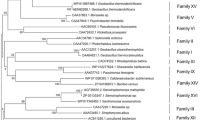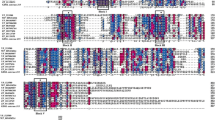Abstract.
A new esterase gene from Xanthomonas vesicatoria (formerly X. campestris) DSM 50861 was identified, cloned from a chromosomal gene library and overexpressed in Escherichia coli. The corresponding DNA fragment contains an ORF of 1,818 bp, encoding a hydrolase of the GDSL esterase family. A protein of about 67 kDa, named Xv_EstE, was expressed from this fragment. A N-terminal signal peptide was processed under low-expression conditions, yielding a 63-kDa mature protein. The predicted amino acid sequence showed distinct homology to esterases of the GDSL family. Based on homology, a catalytic triad Gly-Asp-Ser could be defined. Amino acid sequence alignments and computer-assisted structure prediction indicated the presence of a carboxyl-terminal β-barrel membrane domain which might facilitate binding of Xv_EstE to the outer membrane. This could be verified by differential cell fractionation experiments, in which Xv_EstE was exclusively found in the outer membrane fraction. Xv_EstE showed preferential hydrolytic activity on short chain (up to C8) and para-substituted nitrophenylesters as substrates. However, only long-chain 1-hydroxy-pyrene-3,6,8-trisulfonic acid (HPTS)-fatty acid esters were hydrolyzed. Xv_EstE was also found to be active on a series of substrates of industrial interest, such as 1-methylprop-2-ynyl acetate, for which an enantioselectivity up to 93% ee could be recognized.





Similar content being viewed by others
References
Altschul SF, Gish W, Miller E, Meyers EW, Lipman DJ (1990) Basic local alignment search tool. J Mol Biol 215:403–410
Arpigny JL, Jaeger KE (1999) Bacterial lipolytic enzymes: classification and properties. Biochem J 343:177–183
Ausubel FM, Brent R, Kingston RE, Moore DD, Seidman JG, Smith JA, Struhl K (2001) Current protocols in molecular biology. Wiley, New York
Balzer D, Ziegelin G, Pansegrau W, Kruft V, Lanka E (1992) KorB protein of promiscuous plasmid RP4 recognizes inverted sequence repetitions in regions essential for conjugative plasmid transfer. Nucleic Acids Res 20:1851–1858
Bradford MM (1976) A rapid and sensitive method for the quantitation of microgram quantities of protein utilizing the principle of protein–dye binding. Anal Biochem 72:248–254
Carinato ME, Collin-Osdoby P, Yang X, Knox TM, Conlin CA, Miller CG (1998) The apeE gene of Salmonella typhimurium encodes an outer membrane esterase not present in E. coli. J Bacteriol 180:3517–3521
Clarke L, Carbon J (1976) A colony bank containing synthetic Col E1 hybrid plasmid representative of the entire E. coli genome. Cell 9:91–99
Devereux J, Haeberli P, Smithies O (1984) A comprehensive set of sequence analysis programs for the VAX. Nucleic Acids Res 12:387–395
Emini EA, Hughes JV, Perlow DS, Boger J (1985) Induction of hepatitis A virus-neutralizing antibody by a virus-specific synthetic peptide. J Virol 55:836–839
Fenselau S, Balbo I, Bonas U (1992) Determinants of pathogenicity in Xanthomonas campestris pv vesicatoria are related to proteins involved in secretion in bacterial pathogens of animals. Mol Plant-Microbe Interact 5:390–396
Finlay BB, Falkow S (1997) Common themes in microbial pathogenicity revisited. Microbiol Mol Biol Rev 61:136–169
Gish W, States DJ (1993) Identification of protein coding regions by database similarity search. Nat Genet 3:266–272
Hantke K (1981) Regulation of ferric iron transport in Escherichia coli K12: isolation of a constitutive mutant. Mol Gen Genet 182:288–292
Hauben L, Vauterin L, Swings J, Moore ER (1997) Comparison of 16S ribosomal DNA sequences of all Xanthomonas species. Int J Syst Bacteriol 47:328–335
Henderson IR, Navarro-Garcia F, Cataro JP (1998) The great escape: structure and function of the autotransporter proteins. Trends Microbiol 6:370–378
Jähnig F (1990) Structure predictions of membrane proteins are not that bad. Trends Biochem Sci 15:93–95
Jones JB, Bouzar H, Stall RE, Almira EC, Roberts PD, Bowen BW, Sudberry J, Strickler PM, Chun J (2000) Systematic analysis of xanthomonads (Xanthomonas spp) associated with pepper and tomato lesions. Int J Syst Evol Microbiol 50:1211–1219
Jose J, Jähnig F, Meyer TF (1995) Common structural features of IgA1 protease-like outer membrane protein autotransporters. Mol Microbiol 18:378–380
Jose J, Bernhardt R, Hannemann F (2001) Functional display of active bovine adrenodoxin on the surface of E. coli by chemical incorporation of the [2Fe–2S] cluster. Chem Biochem 2:695–701
Klingsbichel E (1996) Esterase EstA from Pseudomonas marginata: heterologous expression, biological, biochemical, and biocatalytical characterization. PhD thesis, Technical University of Graz, Graz
Koebnik R, Locher KP, Van Gelder P (2000) Structure and function of bacterial outer membrane proteins: barrels in a nutshell. Mol Microbiol 37:239–253
Kyte J, Doolittle RF (1982) A simple method for displaying the hydropathic character of a protein. J Mol Biol 157:105–132
Maurer J, Jose J, Meyer TF (1997) Autodisplay: one-component-system for efficient surface display and release of soluble recombinant proteins from Escherichia coli. J Bacteriol 179:794–804
Maurer J, Jose J, Meyer TF (1999) Characterization of the essential transport function of the AIDA-I autotransporter and evidence supporting structural predictions. J Bacteriol 181:7014–7020
McQueen DA, Schottel JL (1987) Purification and characterization of a novel extracellular esterase from pathogenic Streptomyces scabies that is inducible by zinc. J Bacteriol 169:1967–1971
Oterholm A, Ordal ZJ (1966) Improved method for detection of microbial lipolysis. J Dairy Sci 49:1281–1284
Ozaki E, Sakashita K (1997) Esterase catalyzed regio- and enantio-selective hydrolysis of substituted carboxylates. Chem Lett 741–742
Pautsch A, Schulz GE (1998) Structure of the outer membrane protein A transmembrane domain. Nat Struct Biol 5:1013–1017
Reiter B, Schlacher T, Talker D, Schwab H (2000) Esterase EstC from Burkholderia gladioli is related to plant hydroxynitrile lyases, and rice proteins specifically induced upon bacterial infection. Appl Microbiol Biotechnol 54:778–785
Saito H, Miura K-I (1963) Preparation of transforming DNA by phenol treatment. Biochim Biophys Acta 72:619–629
Sambrook J, Fritsch EF, Maniatis T (1989) Molecular cloning: a laboratory manual, 2nd edn. Cold Spring Harbor Laboratory Press, Cold Spring Harbor, N.Y.
Sanger F, Nicklen S, Coulson AR (1977) DNA sequencing with chain-terminating inhibitors. Proc Natl Acad Sci USA 74:5463–5467
Schlacher A, Stanzer T, Sölkner B, Klingsbichel E, Petersen EI, Schmidt M, Klempier N, Schwab H (1997) New Pseudomonas esterases by genetic engineering. J Mol Catalysis B Enzym 3:25–27
Schlacher A, Stanzer T, Osprian I, Mischitz M, Klingsbichel E, Faber K, Schwab H (1998) Detection of a new enzyme for stereoselective hydrolysis of linalyl acetate using simple plate assay for the characterization of cloned esterases from Burkholderia gladioli. J Biotechnol 62:47–54
Schulz GE (2000) Beta-barrel membrane proteins. Curr Opin Struct Biol 10:443–447
Schwab H, Stubenrauch G, Griengl H, Klempier W, Faber K (1992) Esterase aus Pseudomonas marginata. Austrian patent AT 399886
Sheldon R A (1993) Chirotechnology. Dekker, New York
Silvestri ML (2000) The genome sequence of the plant pathogen Xylella fastidiosa. The Xylella fastidiosa consortium of the organization for nucleotide sequencing and analysis. Nature 406:151–157
Songer JG (1997) Bacterial phospholipases and their role in virulence. Trends Microbiol 4:156–161
Starr MP (1975) A generalized scheme for classifying organismic associations. Symp Soc Exp Biol 29:1–20
Titball RW (1998) Bacterial phospholipases. Soc Appl Bacteriol Symp Ser 27:127S–137S
Turner MK (1995) Advances in the use of enzyme-catalyzed reactions in organic synthesis. Trends Biotechnol 13:253–258
Turner NJ (1994) Recent advances in the use of enzyme-catalyzed reactions in organic synthesis. Nat Prod Rep 11:1–15
Upton C, Buckley JT (1995) A new family of lipolytic enzymes? Trends Biochem Sci 20:178–179
Van den Mooter M, Swings J (1990) Numerical analysis of 295 phenotypic features of 266 Xanthomonas strains and related strains and an improved taxonomy of the genus. Int J Syst Bacteriol 40:348–369
Verevka SV, Miroshnychenko OS (2001) 1-X-3 motif in inter-protein recognition: structures, widespreading and possible practical application. J Mol Recognit 14:315–318
Vogel H, Jähnig F (1986) Models for the structure of outer membrane proteins of Escherichia coli derived from Raman spectroscopy and prediction methods. J Mol Biol 190:191–199
Wang H, Dowds BCA (1993) Phase variation in Xenorhabdus luminescens: cloning and sequencing of the lipase gene and analysis of its expression in primary and secondary phases of the bacterium. J Bacteriol 175:1665–1673
Wilhelm S, Tommassen T, Jaeger KE (1999) A novel lipolytic enzyme located in the outer membrane of Pseudomonas aeruginosa. J Bacteriol 181:6977–6986
Williamson G, Kroon PA, Faulds CB (1998) Hairy plant polysaccharides: a close shave with microbial esterases. Microbiology 144:2011–2023
Acknowledgements
This work was supported by the Austrian FWF, SFB Biocatalysis, project number F001 0101. We thank Dr. Erich Lanka for providing us with plasmid pMS470Δ8 and Martina Palzer and Gerit Schmidt-Polaschek for excellent technical assistance.
Author information
Authors and Affiliations
Corresponding author
Rights and permissions
About this article
Cite this article
Talker-Huiber, D., Jose, J., Glieder, A. et al. Esterase EstE from Xanthomonas vesicatoria (Xv_EstE) is an outer membrane protein capable of hydrolyzing long-chain polar esters. Appl Microbiol Biotechnol 61, 479–487 (2003). https://doi.org/10.1007/s00253-003-1227-5
Received:
Revised:
Accepted:
Published:
Issue Date:
DOI: https://doi.org/10.1007/s00253-003-1227-5




